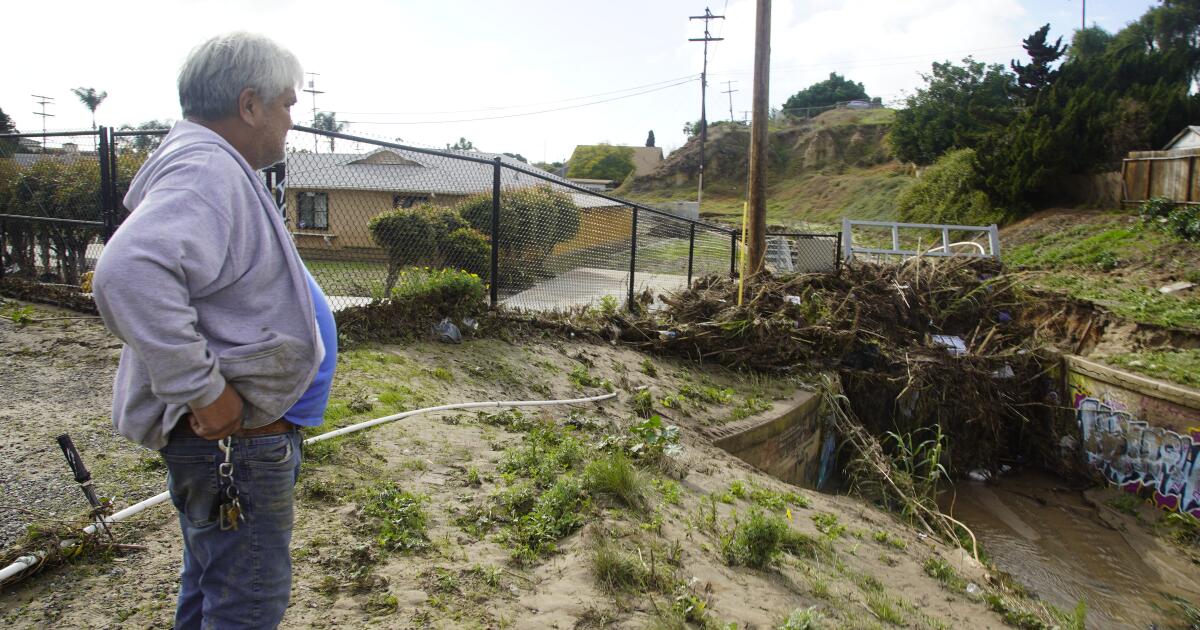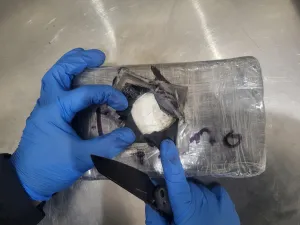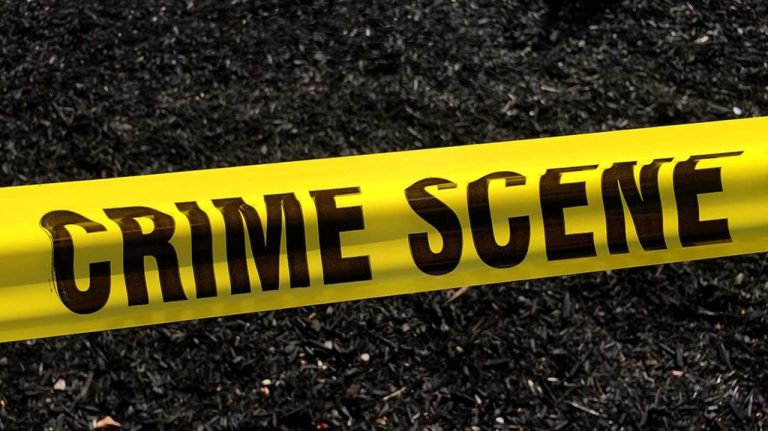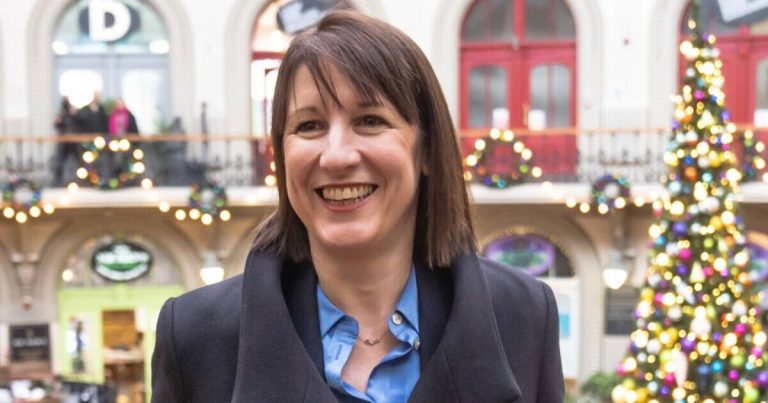
San Diego has long known Chollas Creek needed millions of dollars in maintenance. Then Monday’s storm hit, bringing flooding and devastation to hundreds of people who live near it.
City officials stressed Thursday that very little could have saved the rained-out watershed and its surrounding communities from what they again dubbed a 1,000-year event.
This is free for all readers.
As a public service, The San Diego Union-Tribune is making its storm and flood coverage free for all readers. To support our work and enjoy full access to all our journalism, please consider subscribing. For the latest news as it breaks, get our free email news alerts.
“Even a storm drain system that (was) designed to the golden standard today … would have failed under this situation,” said Kris McFadden, the city’s deputy chief operating officer who oversees stormwater, transportation and public utilities.
“I know that doesn’t work for cleaning people’s homes. It doesn’t save their precious memories. But it serves as an important benchmark for us to meet.
“We know we have to do better, and we are.”
The full impact of Monday’s surprise storm, when a supercharged atmospheric river dropped record-setting rain on the region, is still being assessed.
The sun warmed once-flooded streets Thursday as city crews continued removing mud and sand from neighborhoods and assessing damage to sidewalks and roadways in hard-hit neighborhoods.
City officials said more than 70 streets in neighborhoods including Southcrest, Mountain View, Encanto and others were heavily impacted by the flooding, with mud and debris blocking the public right of way. So far, 16 have been addressed.

Jose Navarro helped load his bedroom mattress into a trash truck to be hauled away to the landfill Wednesday. Jose and his wife, Martha, were among the many residents on Beta Street that were severely effected flood damage.
(Nelvin C. Cepeda/The San Diego Union-Tribune)
More than 100 workers form the city’s Environmental Services Department have been deployed to help remove storm-damaged household and yard items. The work will take days to complete, city officials said. So far, more than 1,000 tons of trash, mud and debris had been removed from flooded neighborhoods. City workers also went door-to-door Thursday to help residents dispose of hazardous materials such as batteries, paint, pesticides, propane tanks and medications.
And beginning Friday, stormwater teams were expected to begin to clear debris from storm culverts — work that carries a new layer of urgency since another storm is expected to roll into the region next week.
“This is an area that needs all the protection we can get as immediately as we can possibly do it, and that’s what we’re doing,” McFadden said.
In Southcrest on Thursday, recovery was very much still in progress.
On Beta Street — one of the hardest hit roadways — dozens of city sanitation workers helped residents load muddy furniture, plaster and other items into the back of garbage trucks. Many of the homes’ interiors were already being gutted by homeowners or contractors who appeared in the flood’s wake, residents said.
Angela Hampton, who lives a few doors down from the intersection of Beta Street and South 38th Street, said she swam to safety Monday while holding her two dogs.
When she returned home this week, a contractor told her the interior of her house would need to be completely redone due to concern over structural damage and possible toxic mold developing. She said the work would take at least six months, and she plans to live in a camper trailer in her backyard while it’s ongoing.
“But I’m one of the very lucky ones. I have flood insurance,” she said. “It’s not adequate flood insurance to be quite honest — I have the bare basics — but I’m so fortunate that I even have that.”
Calculating the damage
As of Thursday afternoon, about 1,900 residents and business owners — more than half of whom hail from the city of San Diego — had filled out the county’s damage assessment survey, which will help officials quantify the storm’s toll in dollars. Officials have also been evaluating damage to public infastructure, which, by mid-Tuesday, had already reached $6 million to $7 million in San Diego. That estimate doesn’t include the more than 400 homes that were damaged. Although those figures are likely higher now, an update was not immediately available Thursday.
The information collected will be used to petition for a federal disaster declaration, a crucial step toward much-needed federal aid.
“We are working with the state and county governments to demonstrate that we have met the thresholds to secure a federal disaster declaration so we can mobilize even more assistance that our affected communities and families desperately need,” San Diego Mayor Todd Gloria said.

Beta Street is among the hardest hit areas damaged by Monday’s flood.
(Nelvin C. Cepeda/The San Diego Union-Tribune)
According to city officials, the federal government will consider a disaster declaration if countywide costs to public facilities reach $15.1 million and statewide losses reach $72.7 million, according to the mayor’s office. A declaration would then trigger financial assistance to reimburse the city for costs to repair public infrastructure.
But both the assistance for public facilities and assistance for residents require a federal disaster declaration, officials said.
Late Wednesday afternoon, Vice President Kamala Harris called Gloria to discuss the impacts of the flooding and the possibility of such a declaration.
“As San Diego begins to recover from an extraordinarily rare and powerful storm, it was comforting to receive Vice President Harris’ sincere offer to be helpful in our time of need,” Gloria said in a statement Thursday.
More immediate efforts to assist the many people affected by Monday’s storm are already underway.
County officials said Thursday that a local assistance center is being set up at the Spring Valley Library and will be open Sunday through Wednesday. The resource will feature local nonprofits, resources and a state insurance commissioner so people can ask any questions they may have.
The county is also working with the Metropolitan Transit Authority and San Diego Association of Governments, or SANDAG, to provide alternative transportation options to those who need to get to their jobs or take other trips to support themselves and their families.
A stretch of the trolley’s Orange Line in East County is still down, after the storm left significant damage to a retaining wall around the 65th Street crossing. MTS, which runs the system, said work includes track repair or replacement. The transit agency is busing people between the three closed stops from Euclid and Lemon Grove. The agency said it did not have an estimate of when the tracks will reopen. About 7 percent of the trolley ridership is affected, according to the agency.
The San Diego Foundation has also launched the San Diego Flood Response Fund — which has already accumulated at least $220,000 — to rapidly funnel flexible resources to the nonprofits working to support communities impacted by the flood. The foundation will match all contributions, dollar for dollar, up to $100,000. Donations can be made online at sdfoundation.org/floodresponse.
“It is at these times where we must focus on what truly matters and that is the well-being of our constituents,” said county Supervisor Monica Montgomery Steppe. “We must work hand-in-hand with local authorities and relief organizations and each other to ensure a swift and effective response to the damages that we face.
“We are in it for the long haul.”
The need for aid
San Diegans impacted most deeply by the flood will need the support. Several residents in Southcrest and Mountain View said Thursday that they didn’t have flood insurance.
Lara Rockwood’s home on 42nd Street in Mountain View butts up against a drainage ditch that sent water rushing into her home Monday morning. Rockwood, who shares the residence with her two sons, a dog, a cat and a bearded dragon, was at work when the flooding began.
“I came home to this,” Rockwood said, gesturing to her hardwood floors, unrecognizable under a thick, hardened layer of mud that cakes the house.
Rockwood, who doesn’t have flood insurance, said she and her children have not stayed at their home since Monday. All their furniture has been removed. “The whole street smells like waste,” she said.

Workers remove mud and debris from the parking lot next to the Happy Hollow Mobile Home Park in National City Tuesday.
(Nelvin C. Cepeda/The San Diego Union-Tribune)
Carlos Gomez and his wife Vanessa Coleman don’t have flood insurance either. Gomez was on a business trip in Florida when his wife called to say she and their three young kids were climbing out a window to save themselves from the rising water.
“Luckily, we have the resources, the ability and the knowledge to take care of it … we’ve been around the trades,” said Gomez, whose family works in construction. “That’s actually made us a lot more fortunate than other people.”
Both Southcrest and Mountain View residents praised the city for sending out garbage bags and sanitation workers in the immediate aftermath. However, both neighborhoods felt more help — and accountability — was needed.
“Someone needs to take responsibility for this,” Gomez said. “Someone needs to financially help those who were affected by this and help us rebuild.”
Chollas Creek projects

Greg Montoya, 68, looks at a clogged storm drain after heavy rain Monday caused flooding near Birch and Una Streets in Southcrest on Tuesday.
(Ana Ramirez/The San Diego Union-Tribune)
Since Monday’s storm, San Diego has faced a wave of criticism over the damage the flooding caused. Some residents have complained the city hasn’t done enough to clear vegetation and debris that can clog waterways. On Thursday, several local officials drew attention to San Diego’s long history of underinvesting in its stormwater system.
Board of Supervisors Chair Nora Vargas said not enough funding had gone to the flood-affected communities for decades. “So here we are now in a dire situation, and we need to ensure that we partner with our community leaders who are are able to get those resources to them now.”
San Diego itself has repeatedly brought attention to its aging infrastructure. But while much work is needed, McFadden, the city’s deputy chief operating officer, said Thursday that the Chollas Creek area hasn’t been ignored.
Last year, crews inspected 2,200 storm drains, cleaned 547 storm drains and removed 113 tons of material in the Chollas Creek area. And before Monday’s storm, the city inspected 82 critical storm drain structures in the watershed.
“We have done so much maintenance in this area,” McFadden said.
The real solution, he said, is capital improvement projects. In 2022, the city secured $733 million in low-interest federal loans to fund stormwater projects over the next five years. McFadden said millions of those funds will be funneled into the Chollas Creek watershed.
Two storm drain improvement projects in the watershed area have already been completed, and a low-impact development project in Logan Heights meant to address water quality and slow down floodwaters is already underway. Four additional stormwater construction projects are slated to begin in the next year, including one in Southcrest.
The city also recently dredged a couple channels in the watershed’s area, including one in Southcrest, removing 2,000 tons from those areas. Another dredging project in Rolando — a bit upstream, but still a critical part of the watershed — has removed 270 tons of material.
All told, McFadden said, there are over two dozen projects planned or underway for the Chollas Creek watershed.
“We acknowledge we need to do a better job of telling the residents what what we’re doing. But you have the city’s commitment to make this better,” he said.
Staff writers Emily Alvarenga, Teri Figueroa and Tammy Murga contributed to this report.






